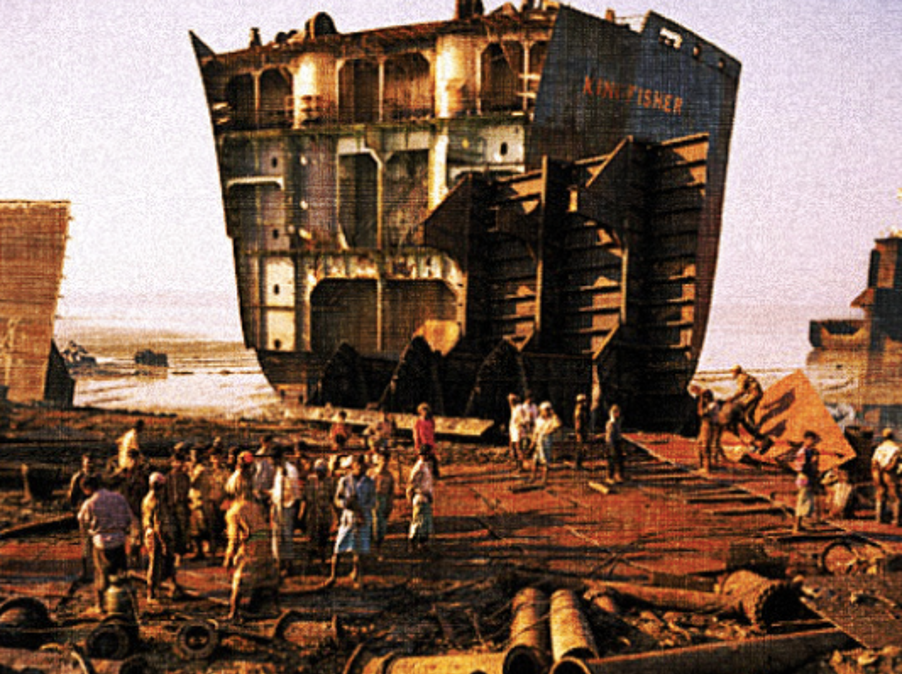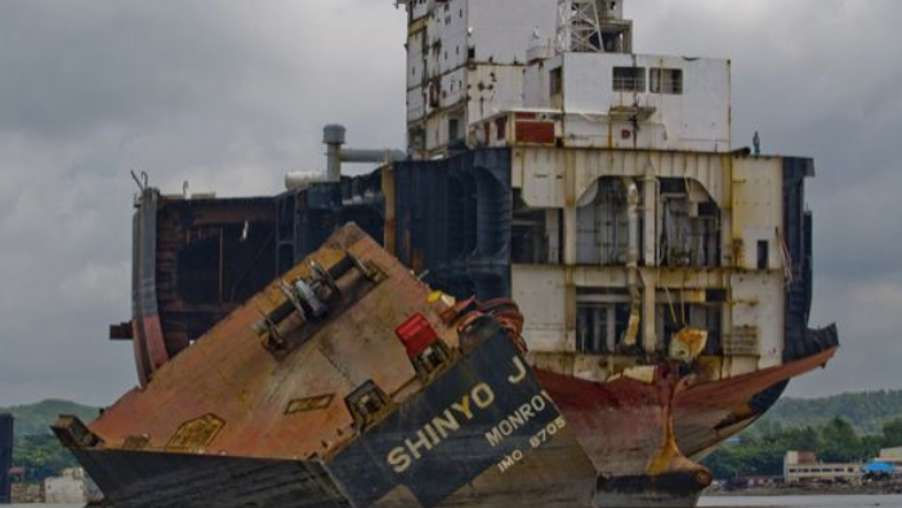1. What is IHM?
IHM is a list that provides ship-specific information on the actual hazardous materials present on board, their location and approximate quantities. The IHM has following parts:
- I. Materials contained in ship structure or equipment
- II. Operationally generated wastes, and
- III. Stores
The IHM Part I shall be prepared and certified for new ships and ships in operation and shall be maintained and kept up to date during the operational life of the ship, while the IHM Part II & III are only required to be prepared when the ship is decided to be sent for recycling. For the preparation of IHM Part I, hazardous materials set out in appendix 1 and 2 of the HKC or Annex I and II of the EU SRR shall be investigated.

IHM Part I for new ships should be developed at the design and construction stage based on suppliers’ declarations on hazardous material content of the products. The determination of hazardous materials present on board existing ships should, as far as practicable, be conducted as prescribed for new ships. Alternatively, in case where documentation is not available, samples shall be taken from the ships to investigate on the hazardous materials.
For new ships all the hazardous materials listed in Appendix 1 & 2 or Annex I & II shall be investigated, while for ships in operation Appendix 1 / Annex I is a must and Appendix 2 / Annex II is to be investigated as far as practicable.
2. What is the relationship between the EU SRR and HKC?
EU SRR is aimed at facilitating early ratification of HKC with higher requirements on control of hazardous materials and approval of ship recycling facilities. Concerning the IHM preparation, in addition to Appendix 1 and 2 of the HKC which lists 13 hazardous materials, two additional hazardous materials have been added by the EU SRR, namely Perfluoro octane Sulfonic Acid (PFOS) and Brominated Flame Retardant (HBCDD). PFOS is listed in Annex I and shall be identified for the ships that are flying a flag of an EU Member State. HBCDD is listed in Annex II and shall be identified for existing ships as far as practicable.
3. Is my fleet affected by the EU SRR and what is the application date?
EU SRR is relevant if a ship is flying the flag of an EU/EEA Member State or if a ship is flagged under a third country (non-EU) but calls at EU ports or anchorages, provided the ship is operating in marine environment (sea going) and is equal to or above 500 gross tonnage.
According to the EU SRR;
- a) New ships flying a flag of an EU member state, shall be delivered with a valid IHM which is certified;
- b) End-of-life ships going for recycling shall have a valid IHM certified and shall be sent to one of the recycling facilities in the EU List of approved ship recycling facilities.
- c) Existing ships flying the flag of an EU member state and third-party ships visiting EU ports and anchorages, from 31 December 2020, shall have a valid IHM on-board, which is certified.
4. How to comply with HKC and EU SRR for new ships?
For new building ships, the ship yard is responsible for the IHM preparation. IHM preparation for new ships is based on documentation which is provided by the suppliers in the form of Material Declarations (MDs) and Suppliers Declaration of Conformity (SDOC).
Many shipyards already have experience of IHM preparation by collecting declarations from suppliers. Regardless of the scope of the IHM, whether HKC or EU SRR, our recommendation to shipyards is that; to instruct the suppliers to fill in and submit the EU SRR material declaration forms for their products, which cover 15 substances instead of 13 as per HKC. Since EU SRR covers the HKC requirements, if the owner orders the IHM as per EU SRR, this will save the effort to collect extra declarations for the two additional substances.

5. How to comply with HKC and EU SRR for existing ships?
For ships in operation, shipowner is responsible for the IHM preparation. To comply with the HKC and EU SRR for your fleet, please follow up below procedures:
a) IHM Part I preparation
The steps for IHM preparation are as follows:
- To collect information about the ship;
- To assess collected information
- To prepare visual and sampling check plan (VSCP);
- On board visual and sampling check,
- To send samples for laboratory analysis and preparation of IHM and IHM inspection report.
For EU SRR compliance for EU/EEA flagged vessels, PFOS must be investigated and HBCDD shall be investigated as far as practicable.
The whole process requires close cooperation of several parties and at best it would need one month until the IHM inspection report is finalized, therefore an early planning is highly recommended.
Once the IHM and IHM inspection report is ready, shipowner shall submit the IHM report to class for approval, and verification.
The IHM preparation shall be carried out by qualified HazMat experts and expert companies approved by class.
6. My ship already has HKC IHM certificate, does she need an EU SRR IHM certificate?
If the vessel is flagged under an EU/EEA Member State, an IHM certificate per EU SRR is required.
If the vessel is flagged under a third county, but visiting EU/EEA ports or anchorages, the vessel would need an EU SRR IHM Statement of Compliance (SoC).
Considering the change of trading route and possibility of change of flag, we advise our customers to prepare the new IHM according to the EU SRR requirements, and to obtain two compliance declarations (EU SRR and HKC).
7. How to get an EU SRR IHM SoC, for non-EU flagged ships with HKC IHM?
For the vessels, which are flying the flag of a third country, and already have a Hong Kong Convention (HKC) compliant IHM, to get the EU SRR SoC, following is required.
- The up-to-date IHM must be submitted to class for approval. For example, if the HKC IHM was prepared 4 years ago, to issue the EU SRR SoC, class needs to see the IHM maintenance procedure of the vessel with supporting documents such as Material Declarations (MD) from suppliers and updated IHM, in case the hazardous material situation of the vessel has changed.
- The owner should also make a statement in their report that after the EU SRR SoC issuance, the maintenance of this IHM shall be done according to EU SRR. That means for the new installations the shipowner shall collect MDs with hazardous materials, including HBCDD. PFOS is not a requirement for non-EU flagged ships however we strongly recommend our clients to use the MD form with 15 hazardous materials, including PFOS and HBCDD for future maintenance.
- The document of item 1. and 2. should be sent to Class for review and approval.
- An IHM initial survey is required to verify the content. EU SRR Statement of Compliance (EU-REC-IHM SoC) can be issued after successful completion of the initial survey with maximum validity of 5 years in harmonization with the ship’s main class renewal date.
8. How to maintain the IHM??
It is the owner’s responsibility to keep the Inventory of Hazardous Materials Part I up to date. Part I of the Inventory shall be appropriately maintained and updated especially after any repair or conversion of a ship. An IHM maintenance procedure shall be implemented including the assignment of a designated person, by keeping records of changes.
If any machinery or equipment or component is added to, removed or replaced or the hull coating is renewed, the MD/SDoC forms provided by the suppliers shall be properly filed and Part I of the IHM shall be updated. Updating is not required if identical parts or coatings are installed or applied. During the IHM renewal survey updated IHM together with maintenance records will be checked by the surveyors.
See detailed requirement in subsections 4.1.2 to 4.1.4 of the IHM Guidelines (Resolution MEPC.269(68)) and Article 5 in EU SRR 1257/2013.
Shipowners may have implemented the procedure based on HKC and it is suggested to review and advance the procedure to EU SRR.
9. What would be the Port State Control measures for inspecting the IHM?
The port state control shall be limited to verifying that either an IHM certificate or a ready for recycling certificate is on board, both supplemented by the verified IHM, which, if valid, shall be accepted for the inspection. A detailed inspection may be carried out where a ship does not carry a valid certificate or there are clear grounds for believing that:
- the condition of the ship or its equipment does not correspond substantially with the particulars of the certificate, and/or IHM Part I; or
- there is no procedure implemented on board the ship for the maintenance of IHM Part I.
A ship may be warned, detained, dismissed or excluded from the ports or offshore terminals under the jurisdiction of a Member State in the event that:
- it fails to submit to the relevant authorities of that Member State a copy of the IHM certificate or the ready for recycling certificate; or
- non-compliance with the control measures for Hazardous Materials listed in appendix 1 to the HKC / Annex I to the EU SRR are identified.
A Member State taking such action shall immediately inform the administration concerned.
Failure to update the IHM shall not constitute a detainable deficiency, but any inconsistencies in the IHM shall be reported to the administration concerned and shall be rectified at the time of the next survey.
10. When shall the IHM Part II & III be prepared?
IHM Part II operationally generated wastes and IHM Part III stores shall be prepared by the shipowner once the decision is given to send the ship for recycling. The IHM Part II and III can be prepared by the crew or if shipowner prefers a hazmat expert can also prepare it.
For IHM Part II & III preparation, please refer to MEPC.269(68) IHM Guidelines as below:
a) Refer to 4.4 & 4.5 in Annex 17, page 8 for IHM part II & part III development requirements;
b) Refer to Table C and Table D in Annex 17, page 14 & 15 for the potentially hazardous materials;
c) Refer to the IHM Part II & III example table in Annex 17, page 18-21;
d) Additionally, IHM Part II & III investigation report with supporting documents, such as inventories, recordings, log books, site pictures, etc. attached as the appendices should be provided to class for approval.
